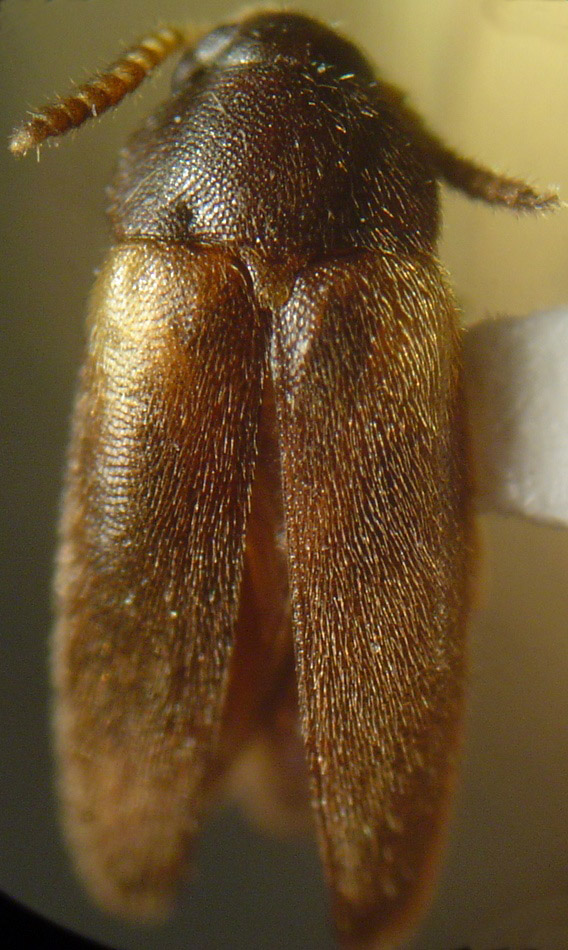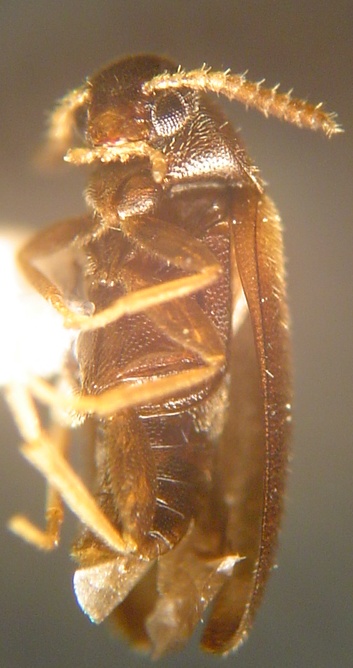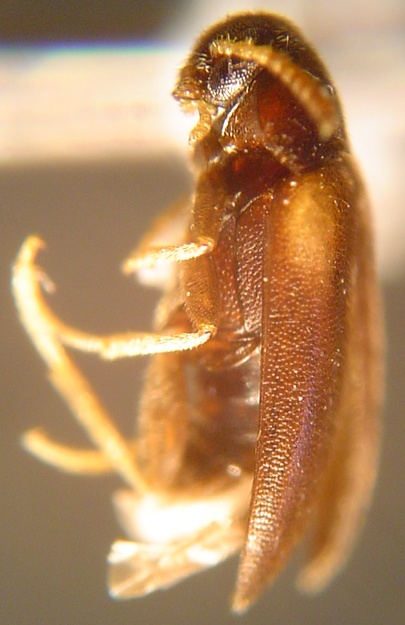Hallomenus sp. nov. ?
|
Hallomenus sp. nov. ? |
Introduction & Bionomics
The Hallomeninae are a subfamily of the Tetratomidae (polypore fungus beetles), although at various times they have also been placed within the Melandryidae (false darkling beetles).
In North America this subfamily is represented by the single genus Hallomenus with six species widely distributed throughout the continent. H. serricornis LeConte has been placed in the subgenus Xeuxes Champion by Nikitsky (1998). The other species fall within Hallomenus sensu stricto.
In Canada, five of these species are known: H. binotatus (Quensel, H. debilis LeConte, H. punctulatus LeConte, H. scapularis Melsheimer, and H. serricornis LeConte (LeSage 1991). Additionally Chantal (1985) has found a species in Quebec which may be undescribed.
In Atlantic Canada, Hallomenus scapularis has only been found in Nova Scotia, although they are doubtless present in New Brunswick as well..
In Québec Chantal (1985) found H. scapularis Melsheimer on polypores growing on dead trunks and branches of trees and H. punctulatus LeConte on Polyporus floriformis Quél. and P. schweinitzii (Fr.) Pat. growing on dead white spruce. Other fungi associated with North American Hallomenus spp. include Laetiporus sulphureus (Fr.), Dichomitus squalens (Kar.) Reid, Osteina abducta (Berk.) Donk, and Trametes serialis (Fr.) Fr. (Lawrence 1991).
In Nova Scotia, H. scapularis has been found in an old-growth Eastern Hemlock forest.
Key to the genus Hallomenus from Chantal (1985).
- A) Elytra lightly striate; greater than 5 mm in length - 2
B) Elytra non-striate; less than 5 mm in length - 3
- A) Antennae serriform; colour generally black - H. serricornis LeConte
B) Antennae not serriform; colour yellowish; prothorax with two curved dark bands; often softened - H. punctulatus LeConte
- A) Colour generally blackish; legs and base of the elytra yellowish - H. scapularis Melsheimer
B) Colour different - 4
- A) Prothorax and scutellum darker than the elytra; the apex is even darker - H. species (undescribed)
B) Prothorax and scutellum are the same colour as the elytra; the sides of the elytra are slightly smoky - H. debilis LeConte

|

|

|
|
Hallomenus scapularis: dorsal habitus |
Hallomenus scapularis: ventral habitus |
Hallomenus scapularis: lateral habitus |
References
Chantal, C. 1985. Les Tetratomidae (Coleoptera) du Québec. Fabreries, 11(3): 43-66.
Lawrence, J.F. 1991. Tetratomidae. In: Stehr, F.W. [Ed.], Immature Insects, Volume 2. Kendall.Hunt. Dubuque, IA. pp 504-505.
LeSage, L. 1991. Melandryidae: False Darkling Beetles. In: Bousquet, Y. Checklist of Beetles of Canada and Alaska. Agriculture Canada Publication 1861/E. pp. 246.
Majka, C.G. and Pollock, D.A. 2006. Understanding saproxylic beetles: new records of Tetratomidae, Melandryidae, Synchroidae, and Scraptiidae from the Maritime Provinces of Canada (Coleoptera: Tenebrionoidea). Zootaxa, 1248: 45-68.
Nikitsky, N. B. 1998. Generic Classification of the Beetle Family Tetratomidae (Coleoptera: Tenebrionoidea) of the world, with a description of new taxa. Pensoft, Sofia, Bulgaria. 80 pp.
Young, D. K. and Pollock, D. A. 2002 Tetratomidae Billberg 1820. In: Arnett, R. H., Jr., Thomas, M. C., Skelley, P. E., and Frank, J.H. [Eds]. 2002. American Beetles, Volume 2: Polyphaga: Scarabaeoidea through Curculionoidea.. CRC Press, Boca Raton, USA. pp. 413-416.
Many thanks to Claude Chantal of the Association des entomologistes amateurs du Québec who has provided much useful assistance, and to Darren A. Pollock, of Eastern New Mexico University.
(c) All rights reserved. Christopher Majka & Empty Mirrors Press